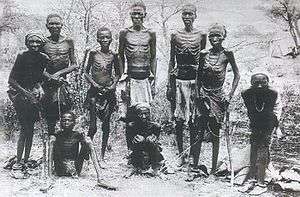Battle of Waterberg
| Battle of Waterberg | |||||||
|---|---|---|---|---|---|---|---|
| Part of the Herero Wars | |||||||
 Surviving Herero after the escape through the arid desert of Omaheke | |||||||
| |||||||
| Belligerents | |||||||
|
| Herero | ||||||
| Commanders and leaders | |||||||
|
| Samuel Maharero | ||||||
| Strength | |||||||
| 2,000 | 3,500 - 6,000 warriors with their families | ||||||
| Casualties and losses | |||||||
| 26 KIA and 60 WIA | unknown, but high | ||||||
The Battle of Waterberg took place on August 11, 1904 at the Waterberg, German South-West Africa (modern day Namibia), and was the decisive battle in the German campaign against the Herero.
Armies
The German Imperial Forces were under the command of Lieutenant General Lothar von Trotha and numbered just over 1,500.[1][2] They were armed with 1,625 modern rifles, 30 artillery pieces and 14 machine guns.
The Herero were under the command of Samuel Maharero and – in expectation of peace negotiations – had assembled some 3,500-6,000 warriors along with their families.[1][2] The total number of Hereros in the area is estimated at 25,000 to 50,000. The rest were armed with traditional close combat weapons called kirri.
Preparations for battle
From the opening of the Herero Revolt in January 1904 until June 11, 1904, the German military efforts had been directed by colonial Governor Colonel Theodor Leutwein.[3] Leutwein combined a policy of military pressure with communication with the Herero to negotiate a settlement to the hostilities. The Germans achieved moderate military success in a series of skirmishes before cornering the Herero at the Waterberg Plateau. However, the Kaiserreich replaced Leutwein with Lieutenant General Lothar von Trotha, expecting Trotha to end the revolt with a decisive military victory.
The Waterberg Plateau where the Herero concentrated lay 100 km east of the railhead source of German supplies, so Trotha spent nearly three months (June, July, and part of August) transporting troops and supplies by ox-drawn carts to the site of the expected battle. In the meantime, the Herero, estimated around 60,000 men, women, and children, with an equal number of cattle, drew on meager grass and water supplies while awaiting overtures from the Germans.
Battle


Execution of Trotha’s battle plan began on August 11, 1904. The German commander intended part of his force to squeeze the Herero south of the Plateau with columns from the east and west while two more columns would seal off the escape route to the south and southeast. The commander of the southeastern blocking column, however, failed to maneuver his troops into position in a timely fashion, and to communicate his tardiness to Trotha. Meanwhile, the western advancing column did not stop at the appointed line and pressed the Herero through the unclosed gap created by the failure of the southeastern troops. The bulk of the Herero and their cattle escaped eastward into the Omaheke desert.
Trotha and his staff were unprepared for their failure, and at the end of an attenuated supply line and occupying ground thoroughly foraged by the Herero, the Germans could not immediately pursue the Herero. While signaling to Berlin a complete victory and subsequent pursuit, Trotha began to move his force westward toward the railroad. The Germans had won a tactical victory by driving the Herero from Waterberg, but had failed in their intentions to end the Herero Revolt with a decisive battle. Trotha soon thereafter ordered the pursuit of the Herero eastward into the desert, intending to prevent Herero reorganization by depriving them of pastureland and watering holes. This campaign caused most of the deaths of Herero people during the Revolt, and resulted in the notorious extermination order of October 2, 1904.[4]
The aftermath
On 2 October, von Trotha issued the infamous extermination order: "Any Herero found within the German borders with or without a gun, with or without cattle, will be shot".[5]
While most Herero escaped the battle, their retreat led to the near extinction of their people. Many of the refugee Hereros died of thirst and exhaustion during their trek through the desert. German patrols later found skeletons around holes 8–16 m (25–50 ft) deep dug in a vain attempt to find water.
Samuel Maharero and about 1,000 of his men managed to cross the Kalahari into the Bechuanaland Protectorate. The British offered the Hereros asylum under the condition that they would not continue their revolt on British soil.
The site of the battle is today located within Waterberg Plateau Park. A military graveyard exists below the rest camp where the German soldiers who perished in the Battle of Waterberg are buried.
References
- 1 2 Irwing, Keith (ed.). "The Battle of Waterberg, part 1". namibia-1-on-1.com. Retrieved 25 June 2013.
- 1 2 Irwing, Keith (ed.). "The Battle of Waterberg, part 2". namibia-1-on-1.com. Retrieved 25 June 2013.
- ↑ This summary is taken from Isabel V. Hull, Absolute Destruction: Military Culture and The Practices of War in Imperial Germany (Ithaca: Cornell University Press, 2005), Chapter 1.
- ↑ See also Helmut Bley, South-West Africa Under German Rule, 1894-1914 (Evanston, Ill., Northwestern University Press, 1971); Jon Bridgman, The Revolt of the Hereros (Berkeley: University of California Press, 1981); Jan-Bart Gewald, Towards Redemption: A Socio-Political History of the Herero of Namibia between 1890 and 1923 (Leiden, 1996); and Kirsten Zirkel, "Military Power in German Colonial Policy: The Schutztruppen and Their Leaders in East and South-West Africa, 1888-1918," in David Killingray and David Omissi, eds., Guardians of Empire: The Armed Forces of the Colonial Powers, 1700-1964 (New York, 1999).
- ↑ http://www.namibia-1on1.com/a-northern/battle-of-waterberg-2.html
External links
| Wikivoyage has a travel guide for Waterberg Plateau Park. |
